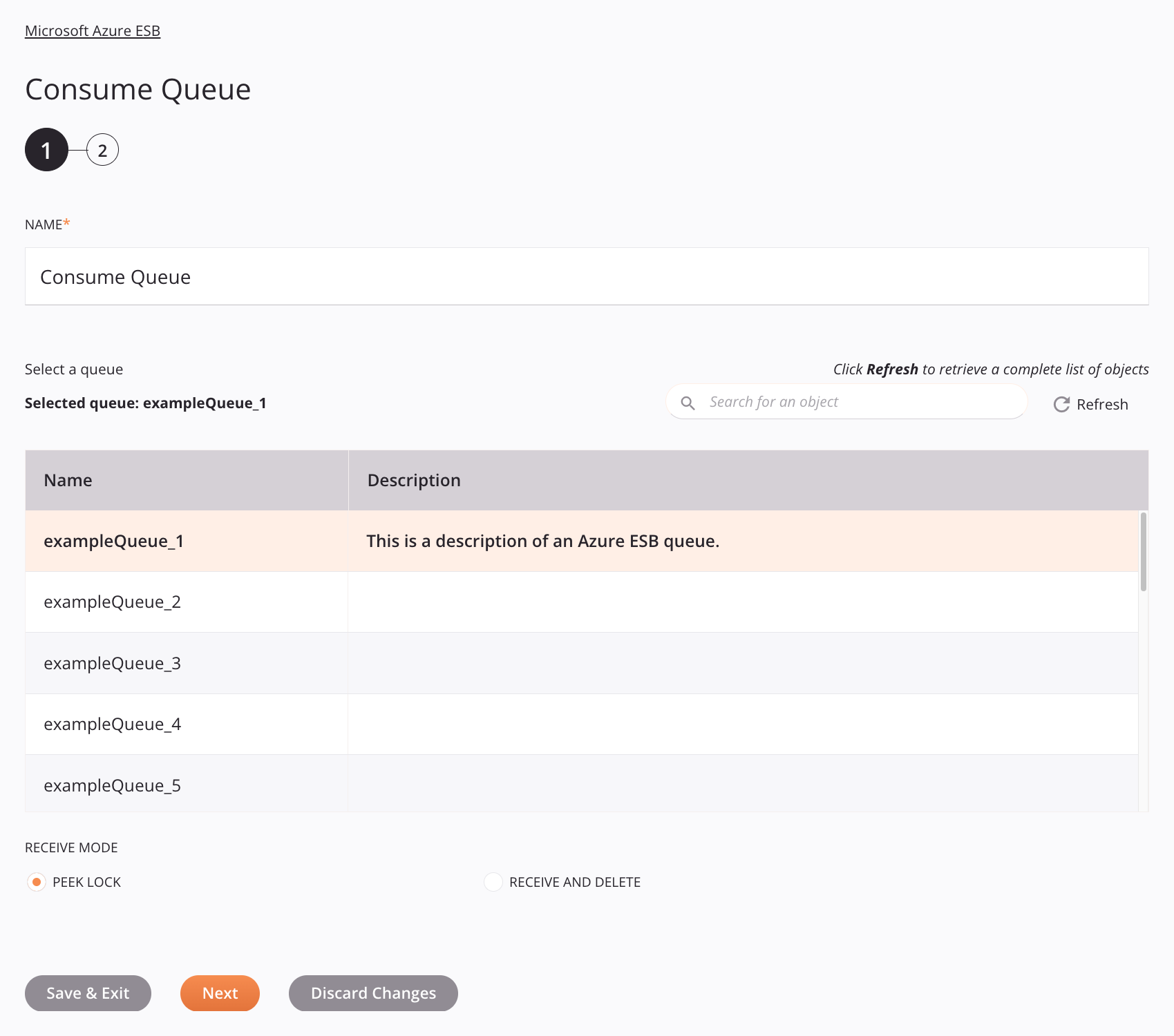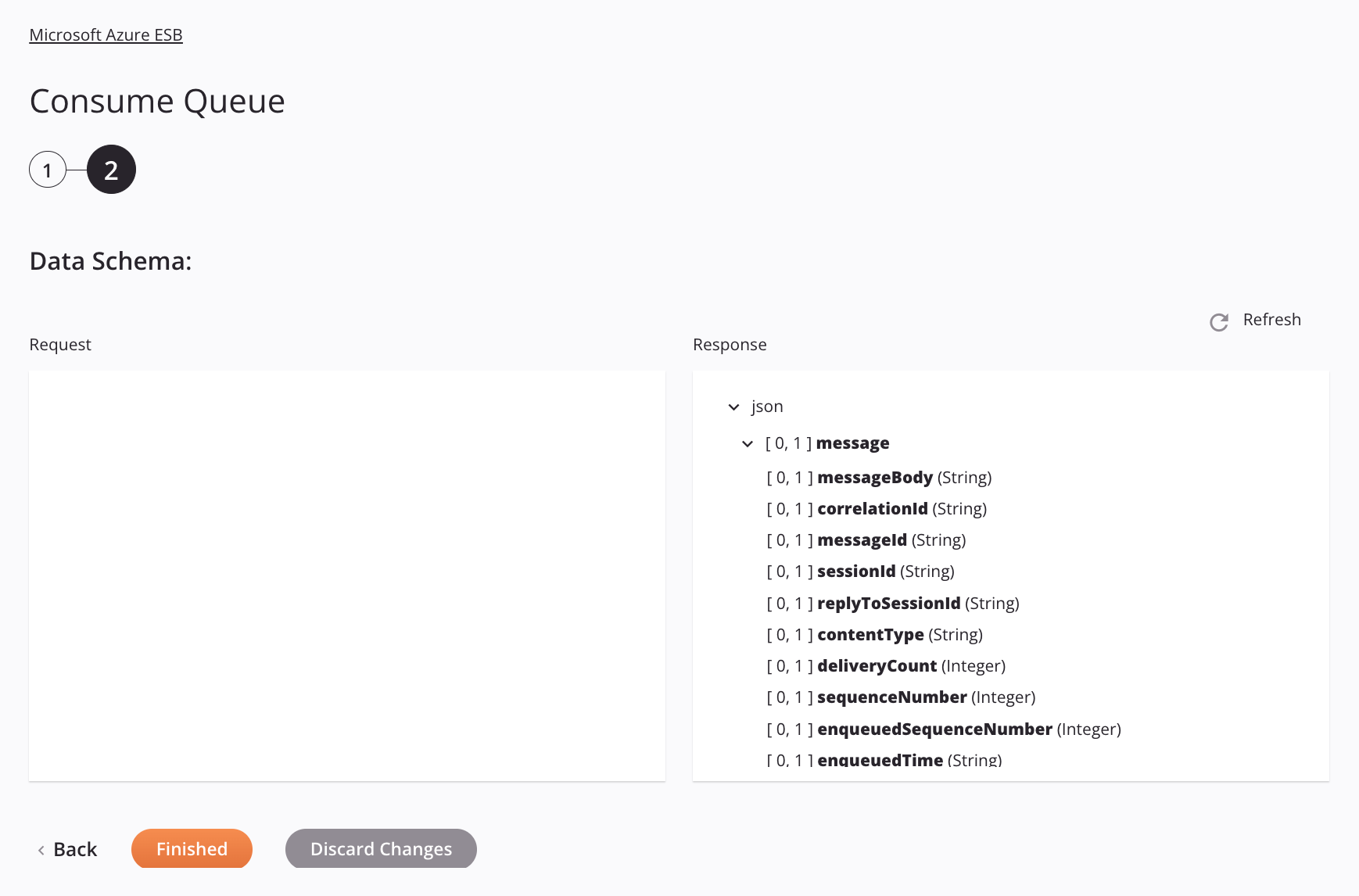Microsoft Azure ESB Consume Queue (Beta) Activity¶
Introduction¶
A Microsoft Azure ESB Consume Queue (Beta) activity, using its Microsoft Azure ESB connection, consumes messages from a Microsoft Azure Service Bus queue and is intended to be used as a source in an operation.
Important
To use the Consume Queue (Beta) activity, the authorization policy rule referenced in the Microsoft Azure ESB connection Policy Name must include listen rights.
Note
This activity is currently released as a beta version. Feedback on bugs and suggested enhancements can be provided through your Customer Success Manager (CSM).
Prerequisites¶
To use the Consume Queue (Beta) activity, these prerequisites must be met:
-
A Private Agent version 10.70 or later (for 10.x Private Agents) or 11.8 or later (for 11.x Private Agents). For Private Agent Groups that contain multiple agents, the Private Agent version must be 10.78 or later (for 10.x Private Agents), or 11.8 or later (for 11.x Private Agents).
-
To fully benefit from the listening service's load-balancing and fault-tolerance features, it is recommended to have a minimum of two Private Agents in the Agent Group.
-
The Private Agent must have the listening service enabled as described in Enable the Listening Service on the Agent. This is a manual step in configuration and is not enabled by default.
-
Once an operation is deployed, the Cloud Studio project must have the listening service enabled at both the operation level and the activity level as described in Enable the Listening Service on the Operation and Activity. This is manual step performed at the time of project design or project management.
Create a Microsoft Azure ESB Consume Queue (Beta) Activity¶
An instance of a Microsoft Azure ESB Consume Queue (Beta) activity is created from a Microsoft Azure ESB connection using its Consume Queue (Beta) activity type.
To create an instance of an activity, drag the activity type to the design canvas or copy the activity type and paste it on the design canvas. For details, see Create an Activity Instance in Component Reuse.
An existing Microsoft Azure ESB Consume Queue (Beta) activity can be edited from these locations:
- The design canvas (see Component Actions Menu in Design Canvas).
- The project pane's Components tab (see Component Actions Menu in Project Pane Components Tab).
Configure a Microsoft Azure ESB Consume Queue (Beta) Activity¶
Follow these steps to configure a Microsoft Azure ESB Consume Queue (Beta) activity:
-
Step 1: Enter a Name and Select a Queue
Provide a name for the activity and select a queue. -
Step 2: Review the Data Schemas
Any request or response schemas are displayed.
Step 1: Enter a Name and Select a Queue¶
In this step, provide a name for the activity and select a queue. Each user interface element of this step is described below.

-
Name: Enter a name to identify the activity. The name must be unique for each Microsoft Azure ESB Consume Queue (Beta) activity and must not contain forward slashes
/or colons:. -
Select a Queue: This section displays queues available in the Microsoft Azure ESB endpoint.
-
Selected Queue: After a queue is selected, it is listed here.
-
Search: Enter any part of the queue name into the search box to filter the list of queues. The search is not case-sensitive. If queues are already displayed within the table, the table results are filtered in real time with each keystroke. To reload queues from the endpoint when searching, enter search criteria and then refresh, as described below.
-
Refresh: Click the refresh icon
 or the word Refresh to reload queues from the Microsoft Azure ESB endpoint. This may be useful if queues have been added to Microsoft Azure Service Bus. This action refreshes all metadata used to build the table of queues displayed in the configuration.
or the word Refresh to reload queues from the Microsoft Azure ESB endpoint. This may be useful if queues have been added to Microsoft Azure Service Bus. This action refreshes all metadata used to build the table of queues displayed in the configuration. -
Selecting a Queue: Within the table, click anywhere on a row to select a queue. Only one queue can be selected. The information available for each queue is fetched from the Microsoft Azure ESB endpoint:
-
Name: The name of the queue.
-
Description: The description of the queue.
-
Tip
If the table does not populate with available queues, the Microsoft Azure ESB connection may not be successful. Ensure you are connected by reopening the connection and retesting the credentials.
-
-
Receive Mode: Select a receive mode, one of Peek Lock or Receive and Delete.
-
Peek Lock: Messages are locked to be explicitly processed. For more information, see Microsoft's documentation on settling receive operations.
Important
Locked queue messages can be unlocked using a Microsoft Azure ESB Unlock Queue Message activity or renewed using a Microsoft Azure ESB Renew Queue Message Lock activity.
-
Receive and Delete: Messages are considered processed as soon as the Service Bus message broker transfers them. If transfers fail, the messages are lost. For more information, see Microsoft's documentation on settling receive operations.
-
-
Save & Exit: If enabled, click to save the configuration for this step and close the activity configuration.
-
Next: Click to temporarily store the configuration for this step and continue to the next step. The configuration will not be saved until you click the Finished button on the last step.
-
Discard Changes: After making changes, click to close the configuration without saving changes made to any step. A message asks you to confirm that you want to discard changes.
Step 2: Review the Data Schemas¶
Any request or response schemas are displayed. Each user interface element of this step is described below.

-
Data Schemas: These data schemas are inherited by adjacent transformations and are displayed again during transformation mapping.
The Microsoft Azure ESB connector uses the Microsoft Azure Service Bus Client for Java v3.6.7. Refer to the API documentation for information on the schema nodes and fields.
-
Refresh: Click the refresh icon
 or the word Refresh to regenerate schemas from the Microsoft Azure ESB endpoint. This action also regenerates a schema in other locations throughout the project where the same schema is referenced, such as in an adjacent transformation.
or the word Refresh to regenerate schemas from the Microsoft Azure ESB endpoint. This action also regenerates a schema in other locations throughout the project where the same schema is referenced, such as in an adjacent transformation. -
Back: Click to temporarily store the configuration for this step and return to the previous step.
-
Finished: Click to save the configuration for all steps and close the activity configuration.
-
Discard Changes: After making changes, click to close the configuration without saving changes made to any step. A message asks you to confirm that you want to discard changes.
Next Steps¶
After configuring a Microsoft Azure ESB Consume Queue (Beta) activity, complete the configuration of the operation by adding and configuring other activities, transformations, or scripts as operation steps. You can also configure the operation settings, which include the ability to chain operations together that are in the same or different workflows.
Menu actions for an activity are accessible from the project pane and the design canvas. For details, see Activity Actions Menu in Connector Basics.
Microsoft Azure ESB Consume Queue (Beta) activities can be used as a source with these operation patterns:
- Transformation Pattern
- Two-target Archive Pattern (as the first source only)
- Two-target HTTP Archive Pattern (as the first source only)
- Two-transformation Pattern (as the first source only)
To use the activity with scripting functions, write the data to a temporary location and then use that temporary location in the scripting function.
Deploy the Operation and Enable Events¶
Once the operation is configured, deploy it. Deploying the operation activates a toggle that is present at the bottom of the operation on the design canvas. By default, event listening is disabled.
To enable event listening for the operation, click the toggle:

When event listening is enabled, the operation will run when it is triggered by the configured event.
Note
Activities that listen to the same event in multiple operations or multiple projects will track those events separately and consume a message in each configured activity. That is, each operation configured with an enabled event will run when the event occurs.
After the operation triggers, you can validate behavior by checking the operation logs. A log entry is made for every message processed by the listening operation.
Administrators can also enable or disable event listening from the Management Console Projects page.